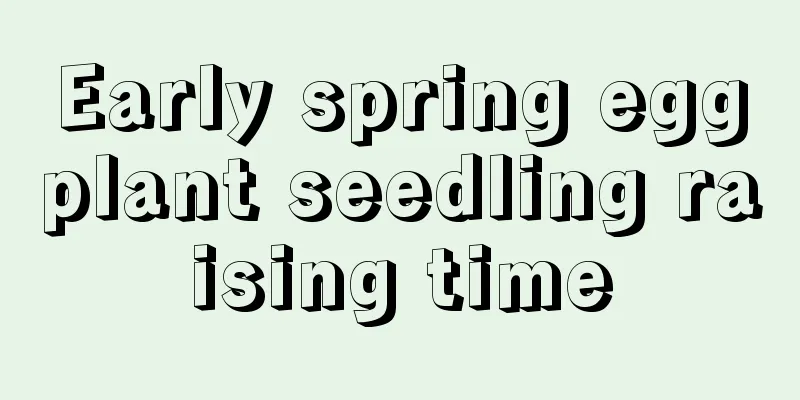Early spring eggplant seedling raising time

|
Many vegetable varieties can now be sown and seedled. In the north, open-air cultivation of eggplant is mainly divided into early-maturing varieties and late-maturing varieties. Early maturing varieties are usually started in early spring and transplanted into the field after the late frost. Late-maturing varieties are raised in late spring, and their transplanting time is more flexible, generally planted between late May and early June. Let’s learn about the time to raise eggplant seedlings in early spring. Early spring eggplant seedling raising time The best time to sow eggplant is usually in spring, and you can start raising seedlings when the temperature is stable above 15℃. Generally speaking, the best time to raise seedlings is from late March to early April. The temperature during this period is suitable, and frost damage or sunburn is not likely to occur during the seedling raising process. It is also conducive to the growth and development of eggplant. For early eggplant, the seedling raising time is generally from early January to early February. Because eggplant seeds have thick, hard and waxy skin, and poor water and air permeability, high-temperature seed soaking and germination are usually used before sowing. Put the seeds in hot water at 70-80℃, stir constantly, and soak them for another day when the water temperature drops below 30℃. Then rub off the mucus on the seed coat, wrap the seeds with a wet cloth, keep them moist, and place them at 25-30℃ to germinate. They will germinate after about 4-6 days, and then sow the germinated seeds in the seedbed. When the seedlings have 5-6 leaves, they can be transplanted. The best time for transplanting is when the ground temperature is stable at above 12°C. For North China, transplanting is generally done in mid- to late April. What are the environmental conditions for growing eggplant? Temperature: Eggplant likes mild and heat-resistant conditions, and the most suitable growth temperature range is 20 to 30 degrees Celsius. In an environment below 20 degrees Celsius, the fertilization and fruit development of eggplant will be affected; when the temperature is below 15-17 degrees Celsius, growth and development will be hindered and flower drop will be serious; below 13 degrees Celsius, growth basically stops; at 0-1 degrees Celsius, frost damage will occur; and above 35 degrees Celsius, the reproduction of floral organs will be hindered. Light: Eggplant likes light and has certain requirements for the length and intensity of sunshine. Under long-day conditions, eggplant grows vigorously, especially in the seedling stage. Extending the daylight hours can promote flower bud differentiation and advance the flowering time. The light compensation point of eggplant is 2000 lux and the saturation point is 40000 lux. If there is insufficient light, the seedlings will develop poorly, the number of long-styled flowers will decrease, the yield will decrease, and the fruit coloring will also be affected. Water: Eggplant likes a humid environment, but is also afraid of waterlogging. Because eggplant has lush branches and leaves and strong transpiration, it requires a lot of water. During the growing period, the field water holding capacity of the soil should be maintained at around 80% and the relative humidity of the air should be maintained at 70% to 80%. Excessive humidity will increase the occurrence of diseases, especially waterlogging in the soil, which can easily lead to root rot and seedling death. Soil: Eggplant is not particularly demanding on soil, but it is best to choose well-drained, fertile soil rich in organic matter. The suitable soil pH range is 6.0-6.5, and a slightly acidic environment is conducive to the growth of eggplant. The above is an introduction to the seedling raising time for early spring eggplant. Now is the best time period for early spring eggplant seedling raising. Friends who want to grow eggplant can hurry up.
|
<<: Can orchids be immersed in pots or can they be watered directly with a watering can?
>>: How to water and fertilize orchids in October
Recommend
Cultivation methods and precautions of water lily
How to cultivate water lily Pot soil selection Wh...
Where is Gastrodia suitable for planting?
Gastrodia elata planting area Gastrodia elata gen...
Are orchids suitable for indoor cultivation?
1. More suitable Orchids are very suitable for gr...
How to judge whether the spider plant needs watering? How to judge whether it is lack of water or too much water
The method of planting spider plants must be corr...
Cultivation methods and precautions of Rainbow Purslane
1. Maintenance methods 1. Soil: The soil prepared...
Can bad eggs be used as fertilizer?
Bad eggs as fertilizer Bad eggs can be used as fl...
How to grow lily seedlings? What to do if they don't grow straight
1. How to raise 1. Suitable soil: Lilies like fer...
When does hibiscus flower bloom?
1. Flowering time Its flowering period is relativ...
Holly cultivation methods and precautions
1. Maintenance methods 1. Soil: Loose soil, good ...
The efficacy and function of Lentil
1. Gardening The growing period of Lentils is rel...
How to grow asparagus fern more vigorously in summer?
As an affordable and easy-to-care-for plant, aspa...
How to prune the succulent rainbow jade
When to prune the rainbow jade The succulent Rain...
The difference between cat's claw and bear's paw
1. Difference in quantity Although the succulent ...
Hawaiian coconut cultivation methods and precautions
1. Pot soil requirements You can use white plasti...
How to Grow Turf
1. Level the land Planting turf has high requirem...









